Recent Posts
Warming Up Wisely: Navigating the Dangers of Space Heaters Safely
4/11/2024 (Permalink)
Space heaters, compact and convenient, have become go-to solutions for individuals seeking extra warmth in specific areas of their homes. While these devices offer comfort, it's essential to acknowledge and address the potential dangers associated with their use. In this blog, we'll explore the risks of space heaters and provide guidelines on how to use them safely to keep your cozy retreat from becoming a fire hazard.
Understanding the Risks
Fire Hazard
- Space heaters can pose a significant fire risk if used improperly. Flammable materials such as curtains, bedding, and furniture can easily catch fire if they come into contact with the heater.
- Electrical Issues
- Overloading circuits or using damaged extension cords can lead to electrical problems, increasing the risk of fire. Regularly inspect your space heater's power cord and plug for any signs of wear or damage.
- Carbon Monoxide Poisoning
- Space heaters that burn fuel can produce carbon monoxide, a colorless and odorless gas that can be deadly. It's crucial to use fuel-burning heaters in well-ventilated areas and never leave them on overnight.
- Tip-Over Accidents
- Space heaters, especially older models, may lack safety features such as automatic shut-off when tipped over. Accidental knocks or bumps can lead to the heater tipping over and causing a fire.
Using Space Heaters Safely
- Choose the Right Heater
- Select a space heater with built-in safety features such as automatic shut-off if it overheats or tips over. Look for a model that meets safety standards and has a label from a recognized testing laboratory.
- Maintain Clearance
- Keep a clear space of at least three feet around the heater. Avoid placing heaters near flammable materials like curtains, bedding, or furniture, and never use them to dry clothes.
- Plug Directly into Outlets
- Plug your space heater directly into an outlet and avoid using extension cords, as they can overheat. If you must use an extension cord, choose a heavy-duty one capable of handling the heater's power load.
- Regular Inspections
- Inspect your space heater regularly, checking for any signs of damage to the cord, plug, or heating elements. If you notice any issues, discontinue use and seek professional repair or replacement.
- Use the Right Fuel
- If you're using a fuel-burning space heater, ensure you're using the correct fuel recommended by the manufacturer. Never use substitute fuels or attempt to modify the heater for a different type of fuel.
- Ventilate Properly
- If you're using a fuel-burning heater, ensure proper ventilation to prevent the buildup of carbon monoxide. Use these heaters in well-ventilated areas, and never leave them on while sleeping.
- Supervise and Turn Off
- Never leave a space heater unattended. Turn it off when you leave the room or go to sleep, and supervise its use when it's operational.
- Educate Household Members
- Ensure that everyone in your household is aware of the proper use and potential risks of space heaters. Discuss safety guidelines and emphasize the importance of responsible usage.
While space heaters offer a cozy solution to chilly days, understanding and respecting their potential dangers is crucial. By following safety guidelines, choosing the right model, and using these devices responsibly, you can enjoy the warmth without compromising your home's safety. Stay warm, stay safe, and make your cozy retreat a secure haven for all seasons.
Emergency Mold Remediation: What to Do in a Crisis
3/13/2024 (Permalink)
We know that dealing with mold can be a real headache, especially when it happens unexpectedly. Mold growth is not only unsightly but can also pose serious threats to your property. That's why, at SERVPRO®, we're here to guide you through the steps of emergency mold remediation. From identifying the issue to taking prompt action, we've got your back!
Identifying the Problem
The first step to tackling any mold crisis is identifying the issue. Keep an eye out for visible signs such as discoloration on walls, ceilings, or floors, a musty odor, or even water damage. Moisture is the primary culprit behind mold growth, so it's crucial to address leaks or water damage promptly.
Isolating the Affected Area
Once you've identified the mold problem, it's essential to isolate the affected area. Close off the space and avoid disturbing the mold to prevent spores from spreading to other parts of your home. You can use plastic sheeting and tape to seal off the affected area and create a containment zone.
Turning Off HVAC Systems
Mold spores can easily travel through the air, so it's crucial to turn off your HVAC system to prevent the spread of mold throughout your home. This step will also help contain the problem and avoid further contamination.
Contacting Professionals
While DIY solutions may seem tempting, mold remediation is best left to the experts. At SERVPRO, our skilled technicians are trained to handle mold emergencies efficiently and safely. Contact us as soon as possible to assess the extent of the damage and develop a customized remediation plan.
Safety First
In any mold emergency, safety should be your top priority. Equip yourself with protective gear, including gloves, goggles, and a mask, before attempting to address the issue. Remember, mold can cause skin irritation, so taking precautions is essential.
Documentation for Insurance
In the midst of a mold crisis, it's easy to overlook the paperwork. However, documenting the damage is crucial for insurance claims. Take photos and keep records of the affected areas to streamline the claims process.
Dealing with mold in an emergency situation can be overwhelming, but with the right steps and professional assistance, you can regain control of your home. At SERVPRO, we're committed to helping you through mold remediation crises, ensuring your home is a safe environment for you and your loved ones. Remember, when it comes to mold, swift action is the key!
Unseen Threats: The Hidden Dangers of Water Damage in Your Home
2/19/2024 (Permalink)
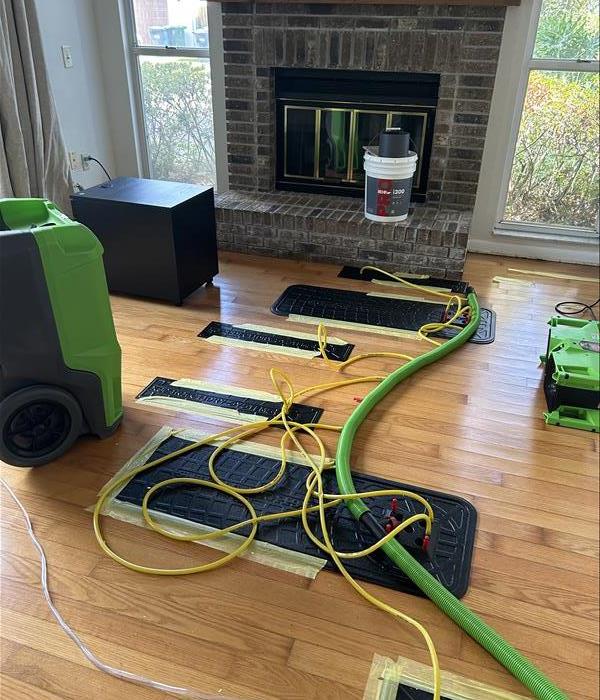 Water damage goes beyond the visible, presenting hidden threats that demand attention.
Water damage goes beyond the visible, presenting hidden threats that demand attention.
Water damage is not just about visible signs like soaked carpets or dripping ceilings. The most insidious threats often lurk beneath the surface, invisible yet potentially harmful to your home. In this blog, we're shedding light on the unseen dangers of water damage, empowering you to recognize and address them before they become major issues.
1. Mold and Mildew Growth
Water damage provides the ideal breeding ground for mold and mildew. These stealthy intruders can flourish in hidden corners, behind walls, or beneath flooring, compromising your indoor air quality and causing extensive damage to your property.
2. Structural Compromises
Beyond what meets the eye, water damage can compromise the structural integrity of your home. Damaged foundations, weakened support beams, and deteriorated framing pose long-term risks.
3. Electrical Hazards
Water and electricity are a dangerous duo. Water damage can compromise wiring and electrical systems, creating potential fire hazards.
4. Unpleasant Odors
The aftermath of water damage often includes unpleasant odors that persist even after visible signs are gone. These lingering smells can be indicative of mold growth, bacteria, or other microbial activities hidden within walls, ceilings, or flooring.
5. Compromised Indoor Air Quality
Water damage can impact indoor air quality, creating an environment that feels less fresh and comfortable. The hidden growth of mold and mildew, along with the release of airborne contaminants, can affect the overall air quality within your home.
6. Undetected Plumbing Issues
Water damage often reveals hidden plumbing issues that, if left unaddressed, can lead to recurrent problems. Beyond the visible damage, water intrusion can expose weaknesses in your plumbing system, such as leaky pipes, corroded fittings, or damaged fixtures.
Water damage goes beyond the visible, presenting hidden threats that demand attention. With this blog, our goal is to equip you with the knowledge to recognize and address these unseen dangers promptly. If your home or business shows signs of water damage, don't hesitate to reach out to our SERVPRO® team today.
Holiday Tips if You Are Traveling or Staying Home
11/6/2023 (Permalink)
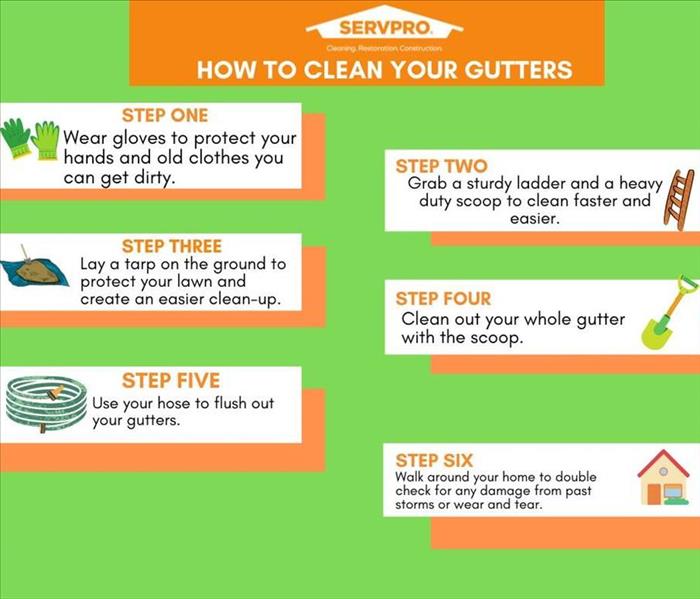 Here are a few tips for cleaning your gutters.
Here are a few tips for cleaning your gutters.
With Thanksgiving approaching in a couple of weeks and Christmas and New Year’s Eve around the corner, families are either preparing to travel, just stay put or both. Depending on which camp you fall under, there are a few things you need to be ready for.
Traveling
If you are planning on going out of town for one of the upcoming holidays, it’s wise to check a few things to elevate the stress of returning home to a potential flooding disaster. Look at your pipes under your kitchen and bathroom sinks, leading to your freezer ice maker, and also your water heater. If you notice any cracks or leaks, make sure to get them fixed.
Outside, you need to make sure your gutters are cleaned and draining properly. And inspect your sump pump and clear out any debris, test it by filling the sump pit and turning on the pump. Last but not least, look over your window seals and check your roof for any leaks, especially if you are expecting any rain or snow storms while gone.
Doing these little things can hopefully prevent water damage. And another reminder, if you don’t have anyone checking on your home while you are gone, it wouldn’t be a bad idea to just turn the water supply off the water main to your home and drain the pipes.
Staying home – time to clean!
Maybe you’re just staying home and you’re hosting family and friends for one of the many holidays, but your house could use a good cleaning. You can reach out to us and we can come over and remove those stains that have accumulated over the months in your carpet or on your furniture. Or maybe there’s a peculiar odor emanating from your vents that needs addressed?
We are ready to come to your rescue and keep you from embarrassment as people enter your home to enjoy the festivities. And that would be one less thing you have to worry about that we can take off your lengthy to-do list at this time of year.
If you have any water damage to address, or if you just need some cleaning done, please contact us at SERVPRO of Gainesville West-Alachua County West at 352-374-6589.
Mold Awareness Month - Equipment FAQs
8/23/2023 (Permalink)
 Dehumidifiers and air scrubbers are part of every mold job.
Dehumidifiers and air scrubbers are part of every mold job.
Mold Awareness Month continues!
This month, equipment is the key. There are two vital pieces of equipment integral to completing proper mold remediation: dehumidifiers and air scrubbers. We want to answer some frequently asked questions that we get about the equipment we use.
Why do we use dehumidifiers?
Mold loves humid places. Before, during, and after the demolition process, large dehumidifiers are used to dry the air and prevent further growth. This creates an environment that discourages mold from spreading. It is especially important to maintain a dry environment once reconstruction begins. The last thing you want is to put materials back in place and lock in moisture!
What are air scrubbers?
Air scrubbers are specialty industrial machines that only a licensed mold remediator would have. The average mold kit you can buy online or in a store wouldn't have anything that can accomplish what they do! They pass air through HEPA filters that catch even the most minute particles. Since mold particles are typically between three and 40 microns in diameter, HEPA filters are the only things that can effectively snatch them out of the air.
Why is it so important to remove spores from the air?
When surface mold is disturbed through demolition, cleaning, or even air currents, it spores into the air. When those spores are inhaled, sensitive individuals could encounter health issues. Additionally, spores naturally want to migrate to another environment conducive to further growth - usually somewhere dark and humid. That is why it is so important to wear respirators and put up containment during a job. However, if you take the containment down without scrubbing the air, the aerosolized spores will still spread to other areas. Thus, air scrubbers run during and after the mitigation process to ensure that the air is clean before containment is removed.
Why do we test for mold after the job?
After cleaning is complete, air scrubbers continue to run inside the containment zone. After the final scrubbing period, a licensed mold assessor will return to the jobsite to run another round of labs. When the results come back, we know that the mold has been properly remediated if all areas are back to normal mold levels.
If you have a mold problem, don't try to tackle it yourself with store-bought solutions! Call an expert like SERVPRO to have it taken care of the right way.
Mold Awareness Month - Containment
8/11/2023 (Permalink)
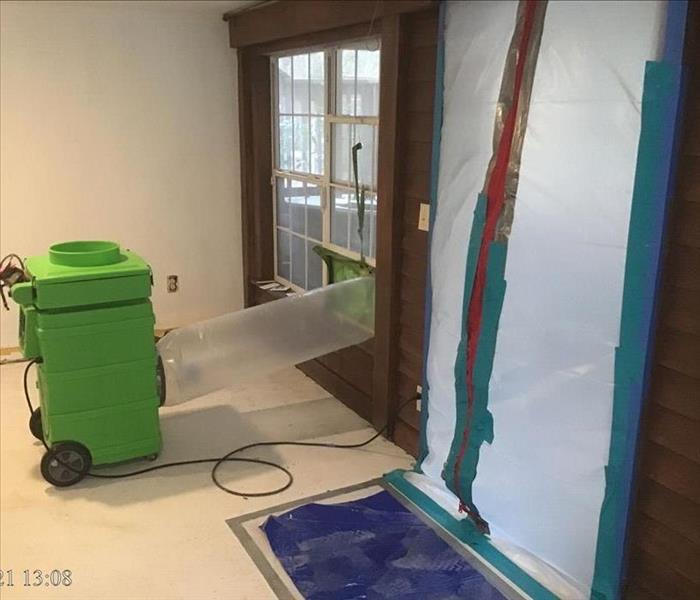 Zipper doors and window seals help keep the outside air out during the job.
Zipper doors and window seals help keep the outside air out during the job.
We're in the second week of Mold Awareness Month! You know what that means! It's time for us to take a look at the right way to restore your home or business from mold damage. That all starts with employing the use of proper containment.
Containment is the act of creating a decontamination (or decon) chamber around the affected area using various methods. We'll discuss those methods in depth, but first we need to think about why a decon chamber is necessary.
You might think that you can remove mold by simply removing moldy materials or cleaning surfaces. While these are both necessary to completing remediation, there are other crucial steps required to do so safely. When mold is disturbed through cleaning and demolition, spores aerosolize and disperse throughout the air. They will then seek another environment suitable for further growth. Yes; improperly removing mold can actually cause it to spread! Aerosolized spores also pose a health risk to susceptible individuals as allergic reactions to mold happen when the spores are inhaled.
How do we solve the problem of aerosolized spores? Containment. Things like sealing windows and putting up transition chambers are especially key to this process. By sealing off the area, we ensure that spores are not able to spread beyond what is already affected. Meanwhile, our dehumidifiers and air scrubbers cleanse the air of spores and return the environment to a normal fungal environment. By the time the job is done, we can remove containment with the confidence that the once contaminated area is now back to normal.
With SERVPRO's expertise and training, you can be sure that we will make mold Like It Never Even Happened.
Mold Awareness Month - Remediation The Right Way
8/1/2023 (Permalink)
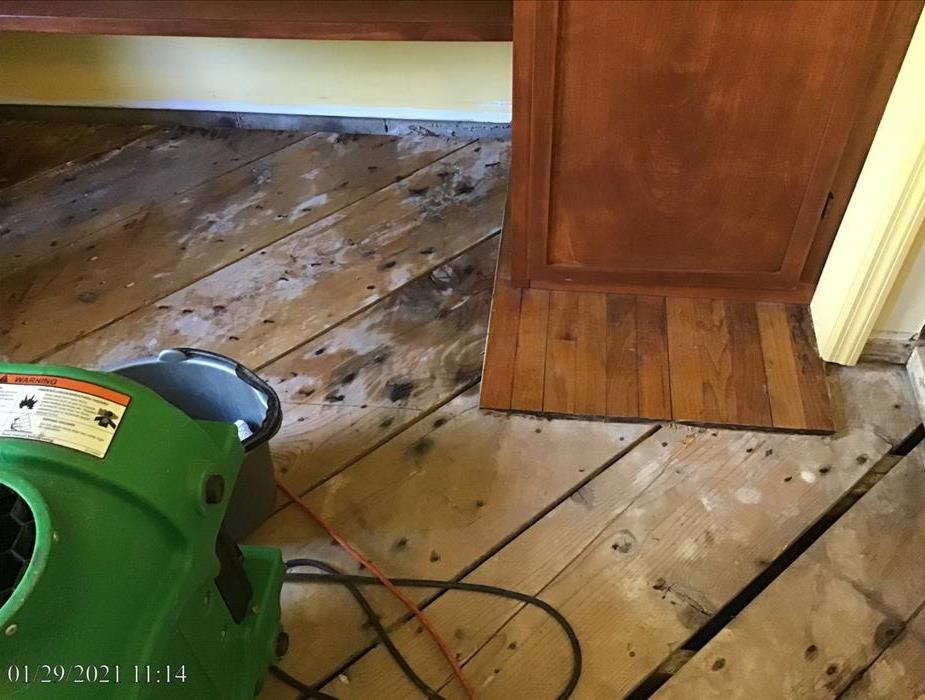 Equipment is a vital part of the remediation process.
Equipment is a vital part of the remediation process.
Strap on your knowledge caps and get ready because August is here, and it's mold awareness month! With the storm season underway, we have decided to pull back the curtain on how we approach mold remediation the right way. Dealing with mold proactively is extraordinarily important, and we are using this month to give you valuable information about how it can be harmful and how we as expert remediators go about getting mold under control.
Mold is a fungus that grows in dark, humid conditions. Often, the source of the growth is a past water intrusion, either via flood or interior loss. If a water loss occurs and is not dried out expeditiously and thoroughly, mold has a chance of growing. In fact, that growth can begin as early as 48-72 hours after the water loss occurs!
A mold issue can be dangerous for residents, which is why you should never attempt to demolish moldy materials such as drywall or carpet on your own. Licensed remediators take several steps to remove mold and create a safe environment once the job is done.
When mold is mitigated by a licensed remediator, there are steps that must be followed in order to ensure the success of the job.
- Inspect the affected area for visible mold.
- Advise client to hire a licensed mold assessor to determine scope, perform a fungal screening, and create a protocol.
- Seclude affected area with containment.
- Place HEPA air scrubbers and dehumidifiers to condition the environment.
- Demolish affected porous materials.
- Dispose of debris.
- Clean the affected area.
- Clean ducts and HVAC system.
- Continue scrubbing the environment for 24 hours after demolition is complete.
- Assessor returns to test again and confirm that mold counts are no longer elevated.
By following the protocol, the risk of mold returning or being dangerous is minimized, which is why you should always leave this sensitive work to the experts. Luckily, SERVPRO® is here to help!
Don’t Throw Out Water-logged Documents
10/3/2022 (Permalink)
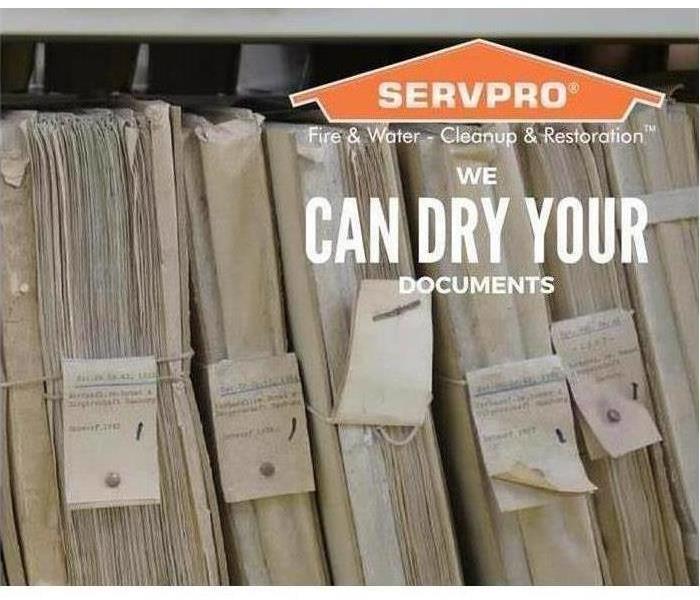 SERVPRO can help you recover sensitive documents.
SERVPRO can help you recover sensitive documents.
After a fire or a flood, your house or business is probably a mess. Not only is there structural damage, but you now realize you have books and important paper documents that are soaked. How will you get these items dried and restored?
SERVPRO is here to help. We are trained and certified in document drying and restoration and can help in stopping the damage from getting worse. Time is of the essence as the longer the documents are soaked or charred, the faster they will deteriorate.
Our technicians box up your damaged items and have them sent to our Document Restoration Team. We have special vacuum freeze-drying technology to salvage your items books and/or paper records. We use the same technique the Library of Congress uses to dry water-damaged books.
Vacuum freeze drying is the most effective way to revive water-damaged documents and is called sublimation — a technique that turns the moisture in the object directly into vapor, skipping the liquid stage to avoid causing more damage. The process can recover even the most delicate items — from documents to photographs and X-rays, to entire business archives. Our Document Restoration Team employees are HIPAA master certified and, once your items arrive at our SERVPRO facility, they are under 24/7 video surveillance to ensure safety.
And if your items may have been exposed to a Category 3 situation (sewage or flood water), we put the items through gamma irradiation, which is a process that cleans and disinfects the documents. This decontamination eliminates all types of bacteria at the molecular level, causing the death of any organisms. And the gamma process does not create residuals or impart radioactivity on to your items.
SERVPRO understands how important it is to preserve important documents and our line of services ensures that you don’t have to worry about what happens to your paper assets when disaster strikes.
If you need sensitive materials restored, contact SERVPRO of Gainesville West/Alachua County West today at 352-374-6589.
Exterior Maintenance Tips to Prevent Water Damage
9/19/2022 (Permalink)
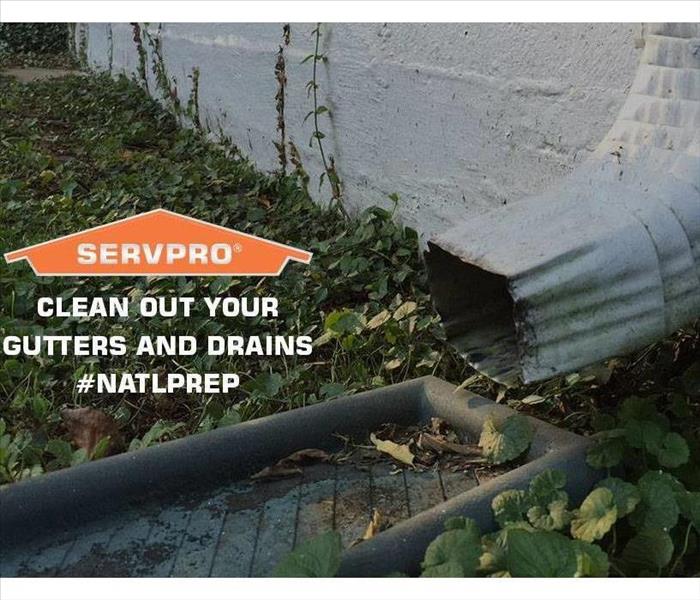 Ensuring your gutters are clean and not full of debris is a great way to prevent potential water damage.
Ensuring your gutters are clean and not full of debris is a great way to prevent potential water damage.
With Hurricane season not over just yet and the constant afternoon downpours North Florida has been experiencing this summer, it is a great time to learn about how you can prevent possible water damage to your home or business.
SERVPRO of Alachua County West/Gainesville West has been serving the community for more than 15 years and has seen its fair share of water damage and all its causes.
Today’s tips focus on exterior maintenance to prevent water damage from rainfall, because heavy rain is a part of living in our area of Florida. Follow these tips for routine inspection and maintenance to help prevent costly water damage.
Clean Your Gutters and Check for Proper Drainage
Clean gutters will drain water off your roof and away from the foundation. Make sure your gutters are clear and remove any leaves and other debris that may have accumulated over the winter. Check that water drains properly through your gutter and out the downspout.
The downspout should direct water away from your home or business. You can purchase an extension that attaches to the downspout so that rainwater will be directed farther away. These are inexpensive and available at any hardware store.
Check Window Seals
This is another inexpensive project. Walk around the outside of your home and inspect the seals around your windows, because improperly sealed windows are another potential source of entry for moisture and rainwater to get into your home. Look for missing/cracked caulk on the outside. From inside the house, visible mold spots or crumbling/peeling walls next to the window can signal leakage in that area.
Increase the Grade of Soil Closest to Your House or Business
Fill in any holes or gaps in landscaping around the exterior where water can pool back toward the home. Replace the dirt with the highest level at the property and gently slope down to the rest of the yard to promote drainage.
Inspect Your Roof
Your roof is potentially a significant point of entry for rain. Check for any loose or damaged shingles and replace them if necessary. Unlike the other projects mentioned, due to the risk involved, you may want to hire a professional roofer to handle this job every few years.
Even with proper maintenance, sometimes Florida’s heavy rains during thunderstorms or even hurricanes create leaks or flooding. If you suspect water damage or experience flooding, give us a call at SERVPRO Gainesville West/Alachua West right away. Not only do we want to help with water damage mitigation quickly, but the faster you address the water damage, the less likely you are to develop mold problems.
We are available 24/7, 365 days a year. Give us a call at 352-374-6589.
A Few Steps Can Go a Long Way to Protect Your Family
9/12/2022 (Permalink)
 SERVPRO offers an Emergency READY profile to help you stay prepared.
SERVPRO offers an Emergency READY profile to help you stay prepared.
September is National Preparedness Month and Hurricane Season is still in full swing, which runs until November 30. While this season has been relatively quiet, with the Atlantic only having five named storms so far, it’s still best to always be prepared.
The key to disaster preparedness is having an emergency plan in place before disaster strikes. The following simple steps can go a long way to protect your family and your property in a weather-related disaster.
Build Basic Emergency Supply Kit
A basic kit should be stocked to supply you and each of your family members with water and food for at least three days. Consider including food for pets, as well as any necessary medications in your kit. Recommended emergency supply kit items include:
- Water (one gallon/person per day)
- Three-day non-perishable food supply
- Manual can opener
- Battery-operated radio, preferably a NOAA Weather radio
- Flashlight and extra batteries
- First aid kit
- Whistle (to signal for help)
- Dust masks or bandanas
- Local maps
- Important documents, such as copies of insurance policies, identification and bank account information
- Matches (in a waterproof container)
Make Family Emergency Plan
You may not be home or with family when disaster strikes. Plan in advance where you will meet and how you will contact each other. Visit ready.gov to access a Family Emergency Plan template to assist in your planning.
Stay Informed
Learn the elevation level of your property
This will help you know how your property could be affected by heavy rainfall and whether it is prone to flooding. Know your community evacuation routes and determine where you would go and how you would get there if evacuation becomes necessary. Finally, listen to local authorities for direction.
Prepare Your Property
In the event of a hurricane or severe storm, you may need to prepare your home for impact. You can do this by covering all of the windows in your home. Permanent storm shutters offer the best protection for windows. A second option is to board up windows with plywood. Tape does not prevent windows from breaking. Keep trees and shrubs around your home trimmed to make them more resilient in high winds. Clear any debris from gutters and downspouts. Secure all outdoor furniture, decorations, garbage cans and any other items not secured.
Establish a SERVPRO Emergency READY Profile for Your Business
SERVPRO developed the SERVPRO® Emergency READY Program to help business owners create an Emergency READY Profile (ERP) for their facility, at no charge. You will work with a SERVPRO of Gainesville West/Alachua County West to gather and document important information about the facility which will become critical if a disaster strikes. Once the ERP is created, business owners have access to their information 24/7 online and by using SERVPRO’s free smartphone app.

 24/7 Emergency Service
24/7 Emergency Service







